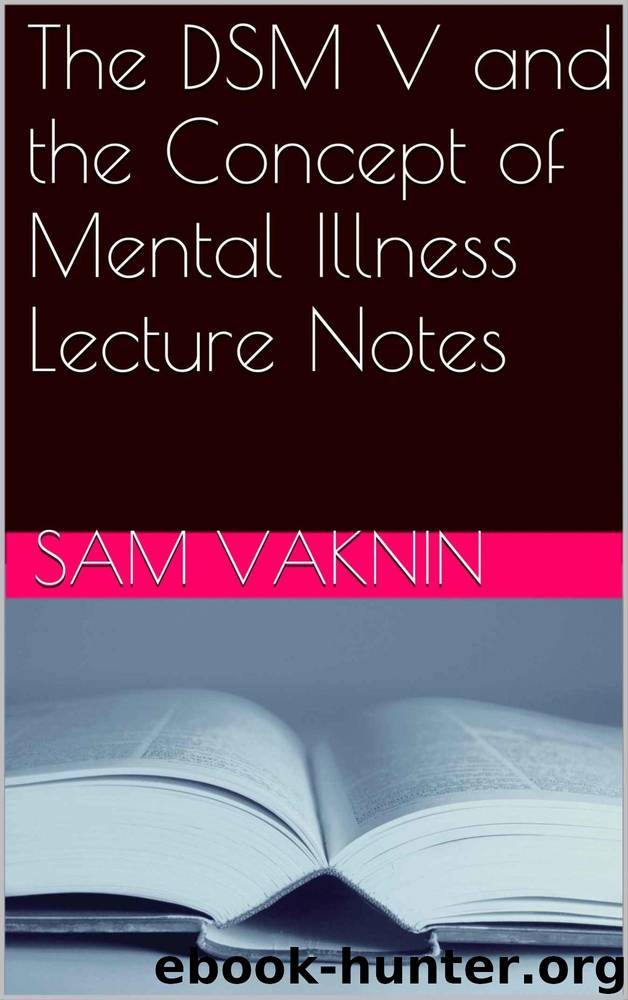The DSM V and the Concept of Mental Illness Lecture Notes by Sam Vaknin

Author:Sam Vaknin
Language: eng
Format: mobi
Publisher: Narcissus Publications
Published: 2011-03-28T21:00:00+00:00
"(It is) a form of mental alienation which has so much the look of vice or crime that many people regard it as an unfounded medical invention (p. 170).
In his book "Die Psychopatischen Minderwertigkeiter", published in 1891, the German doctor J. L. A. Koch tried to improve on the situation by suggesting the phrase "psychopathic inferiority". He limited his diagnosis to people who are not retarded or mentally ill but still display a rigid pattern of misconduct and dysfunction throughout their increasingly disordered lives. In later editions, he replaced "inferiority" with "personality" to avoid sounding judgmental. Hence the "psychopathic personality".
Twenty years of controversy later, the diagnosis found its way into the 8th edition of E. Kraepelin's seminal "Lehrbuch der Psychiatrie" ("Clinical Psychiatry: a textbook for students and physicians"). By that time, it merited a whole lengthy chapter in which Kraepelin suggested six additional types of disturbed personalities: excitable, unstable, eccentric, liar, swindler, and quarrelsome.
Still, the focus was on antisocial behavior. If one's conduct caused inconvenience or suffering or even merely annoyed someone or flaunted the norms of society, one was liable to be diagnosed as "psychopathic".
In his influential books, "The Psychopathic Personality" (9th edition, 1950) and "Clinical Psychopathology" (1959), another German psychiatrist, K. Schneider sought to expand the diagnosis to include people who harm and inconvenience themselves as well as others. Patients who are depressed, socially anxious, excessively shy and insecure were all deemed by him to be "psychopaths" (in another word, abnormal).
This broadening of the definition of psychopathy directly challenged the earlier work of Scottish psychiatrist, Sir David Henderson. In 1939, Henderson published "Psychopathic States", a book that was to become an instant classic. In it, he postulated that, though not mentally subnormal, psychopaths are people who:
"(T)hroughout their lives or from a comparatively early age, have exhibited disorders of conduct of an antisocial or asocial nature, usually of a recurrent episodic type which in many instances have proved difficult to influence by methods of social, penal and medical care or for whom we have no adequate provision of a preventative or curative nature."
But Henderson went a lot further than that and transcended the narrow view of psychopathy (the German school) then prevailing throughout Europe.
In his work (1939), Henderson described three types of psychopaths. Aggressive psychopaths were violent, suicidal, and prone to substance abuse. Passive and inadequate psychopaths were over-sensitive, unstable and hypochondriacal. They were also introverts (schizoid) and pathological liars. Creative psychopaths were all dysfunctional people who managed to become famous or infamous.
Twenty years later, in the 1959 Mental Health Act for England and Wales, "psychopathic disorder" was defined thus, in section 4(4):
"(A) persistent disorder or disability of mind (whether or not including subnormality of intelligence) which results in abnormally aggressive or seriously irresponsible conduct on the part of the patient, and requires or is susceptible to medical treatment."
This definition reverted to the minimalist and cyclical (tautological) approach: abnormal behavior is that which causes harm, suffering, or discomfort to others. Such behavior is, ipso facto, aggressive or irresponsible. Additionally
Download
This site does not store any files on its server. We only index and link to content provided by other sites. Please contact the content providers to delete copyright contents if any and email us, we'll remove relevant links or contents immediately.
Unwinding Anxiety by Judson Brewer(70211)
The Art of Coaching by Elena Aguilar(50071)
The Fast Metabolism Diet Cookbook by Haylie Pomroy(20494)
Rewire Your Anxious Brain by Catherine M. Pittman(17598)
Healthy Aging For Dummies by Brent Agin & Sharon Perkins RN(16614)
Talking to Strangers by Malcolm Gladwell(11898)
The Art of Thinking Clearly by Rolf Dobelli(8857)
Crazy Rich Asians by Kevin Kwan(8357)
Mindhunter: Inside the FBI's Elite Serial Crime Unit by John E. Douglas & Mark Olshaker(7844)
The Compound Effect by Darren Hardy(7571)
Crystal Healing for Women by Mariah K. Lyons(7378)
Therapeutic Modalities for Musculoskeletal Injuries, 4E by Craig R. Denegar & Ethan Saliba & Susan Saliba(7353)
Periodization Training for Sports by Tudor Bompa(7339)
Bodyweight Strength Training by Jay Cardiello(7188)
Becoming Supernatural by Dr. Joe Dispenza(7112)
Wonder by R. J. Palacio(7067)
Tools of Titans by Timothy Ferriss(6956)
Should I Stay or Should I Go? by Ramani Durvasula(6792)
How to Be a Bawse: A Guide to Conquering Life by Lilly Singh(6697)
